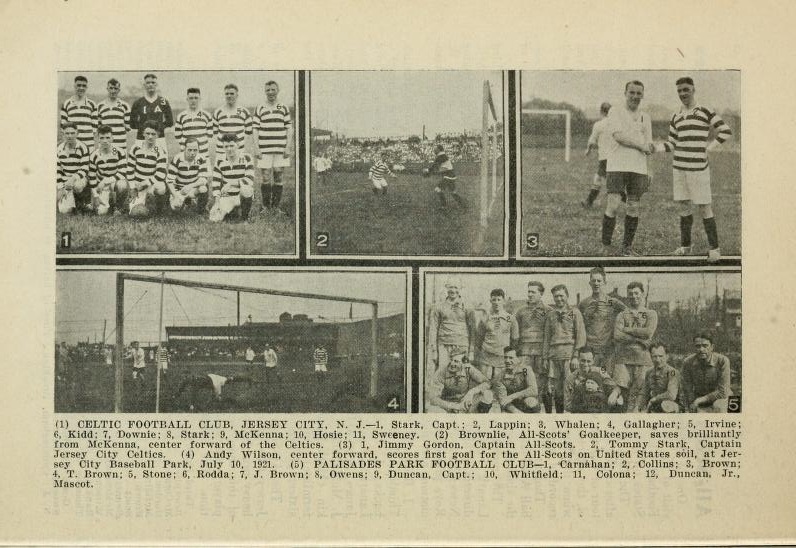Details
Ref: Football clubs (‘soccer’) in the USA called Celtic
Clubs: Boston Celtics, Brooklyn Celtic, New York Celtic, Celtic Jersey City, Rochester Celtic, S.S. Celtic, SS Celtic
Summary
We’d love to find further information on any of these clubs, and would be incredible to find if (Glasgow) Celtic or Belfast Celtic was the influence for these sides and if any ex-pat Celtic players or supporters were part of these clubs in their creation, administration or even played in the teams.
Source:
1) https://archive.org/details/spaldingsofficia04coch/page/62/mode/2up
2) https://soccerhistoryusa.org/ASHA/#archive
(collated all by @andyboyd1967)
Boston Celtics

pic from 1927; in American professional soccer (@BostonGlobe )
See: https://twitter.com/joebloggscity/status/1426822011901431808?s=20
This is an interesting one. I wonder if they played in the green and white hoops, if any ex Celts and if their name was inspiration to be adopted by the basketball team.
Notably the football the kid is holding just says Celtic (singular not plural).
This team predates the famous Basketball team.
In 1931, only a few years after the above picture was taken Celtic toured the US but sadly didn’t play this team (if they were still even around). Celtic did play in Boston on that tour, at the hallowed Fenway Park home of the famous Boston Red Sox. Curiously, Celtic were playing a New York Yankees team at this ground (30 May 1931). In baseball, the Boston Red Sox v New York Yankees is amongst the biggest rivalries anywhere in the sport!
Notably, the New York Yankees team had a clutch of Scottish ex-pats in their side, and so possibly this may likely also have been the same for the Boston Celtics club too, although I assume there will have been Irish ex-pats too. Maybe this is how the name was derived? An ex-pat sympathiser adopted his home club’s colours and names to his new football side. Maybe the name was influenced via Belfast Celtic supporters & ex-pats.
Brooklyn Celtics
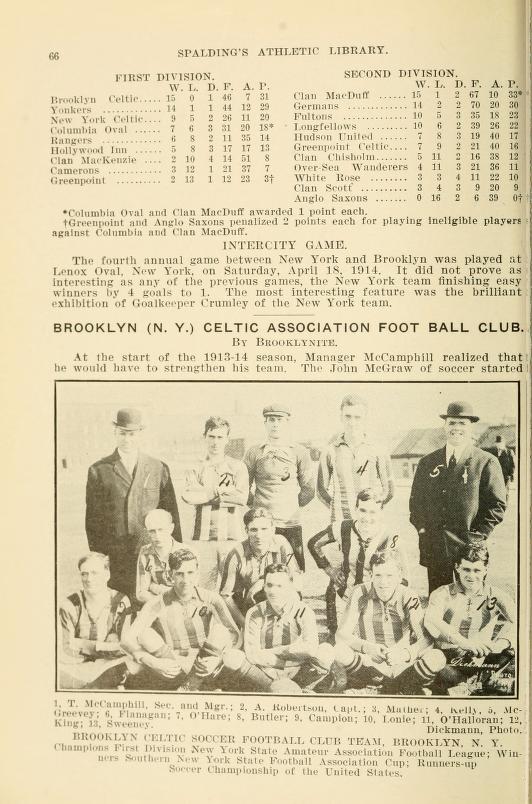
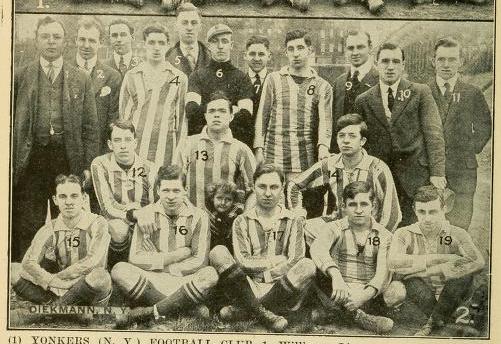

(see below end of page for write up on Brooklyn Celts)
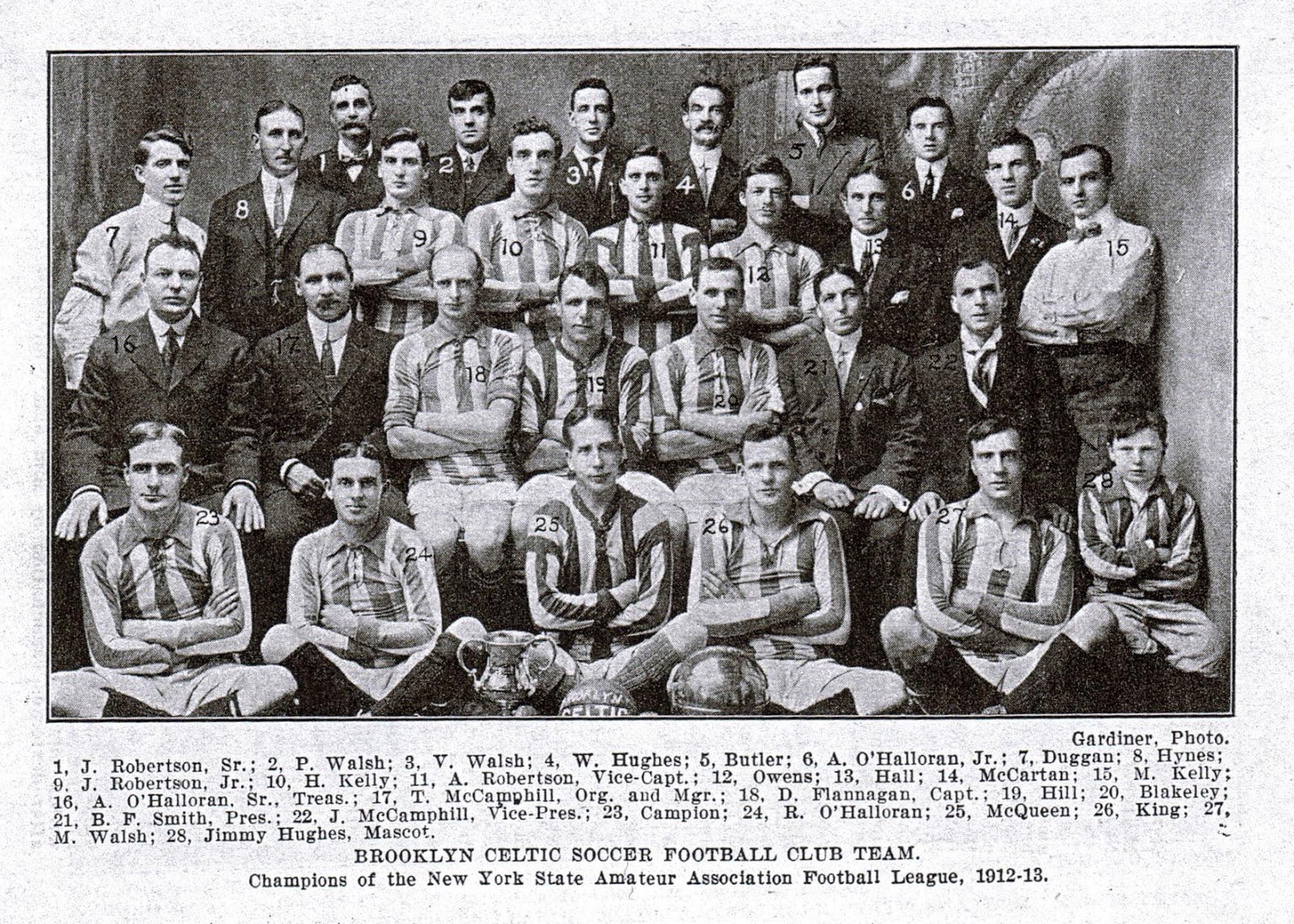
Brooklyn Hibs
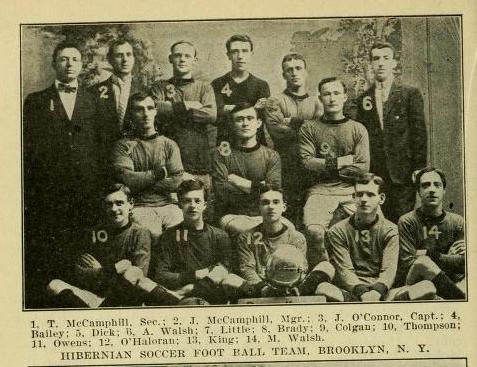
New York Celtic
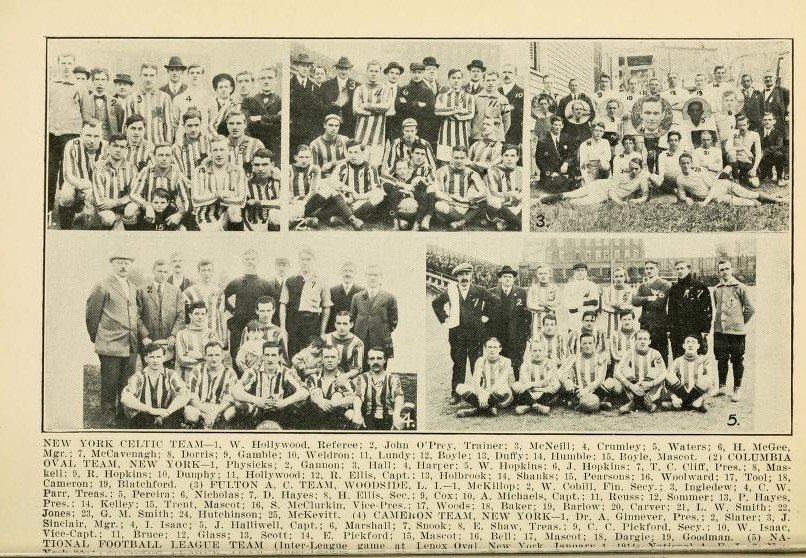
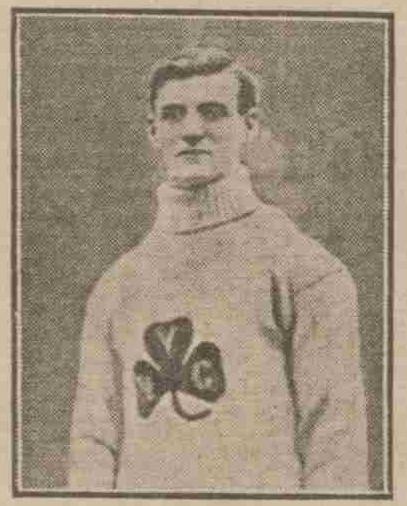
Rochester Celtic 1917
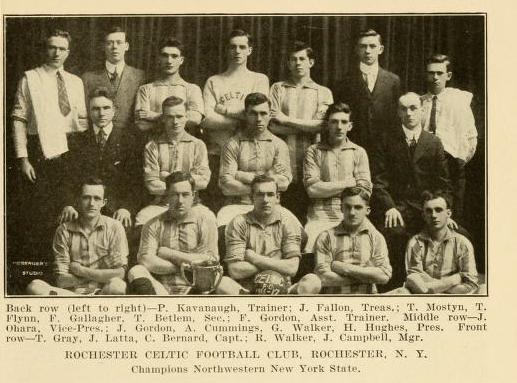
Celtic Football Club, Jersey City
SS Celtic (S.S. Celtic) (1907)
1907, U S S Celtic, based in Brooklyn. Wonder what colours they used?

US Soccer Federation Centennial Moment: BROOKLYN CELTIC
Brooklyn Celtic – Amateur Dynasty
Source: https://soccerarchives.blogspot.com/2013/03/
When it comes to the pioneers of American soccer, the vast wealth of influence came from overseas immigrants. In the same month that the Patron Saint of Ireland is celebrated for St. Patrick’s Day, we hearken back to the days when an Irish club emerged in league football.
One such organization was so dominant that it challenged the best of professional clubs during their hey day. Brooklyn Celtic was led by Irish Manager Tom McCamphill and his brother James. Among its members were at least three sets of brothers, and two sets of fathers and sons.
While James Robertson Sr. played less of a role, the junior Robertson went on to represent the USA in its very first International match in 1916.
The O’Halloran family (father and 2 sons) were the mainstays of the amateur club throughout their existence. They played for several other New York clubs such as the Brooklyn YMCA and representative sides – Ireland, in the International Series. Under the New York Footballers Protective Association, unofficial national teams England, Scotland, Ireland and an early version of Team America, among others, played in annual tournament beginning in 1912.
The rapid rise of organized soccer in the United States prompted both amateur and professional leagues as well as cup tournaments. Brooklyn Celtic won the first of the American Amateur Football Association Cup in 1912. They would follow up with 2 more finals appearances in the National Challenge Cup – now known as the Lamar Hunt U.S Open Cup.
Although they lost both matches to their professional counterparts, they defeated the same teams earlier in the year in other competitions. They dominated the very competitive amateur circuit by winning promotion to the top level in 1911 and went on to win the title 6 of the 7 seasons they played in the league.
They were also runners up in the 1915 American Cup.
The Celtic star forward was a diminutive 5’4″ Roddy O’Halloran. In Brooklyn Celtic’s first season of 1910, three players were chosen for the prestigious All-Brooklyn Team to face the powerful All-New York Stars. Along with forward Mike King and Robert Owen was the 17 year old forward Roddy O’Halloran.
The two forwards, stars in the making, combined for a great goal as described by the newspaper: “After about 20 minutes play, from a pass from his club mate King, O’Halloran dropped the ball over his head …scoring what proved to be the only goal of the game”.
Forward “Mike” King was already a veteran of New York area soccer. However, it was the short and spindle of a young O’Halloran, who only arrived in America in 1907, that became a catalyst for the Irish club. First appearing on the soccer scene in 1908 while playing for the Brooklyn Hibernians, Tom McCamphill incorporated Roddy and several O’Halloran relatives into the Celtic club, the youngest even serving as mascot.
Roddy spent part of the 1910 season with Brooklyn AFC, professionals of the National Association Football League. While the professional circuit played on Sundays, Celtic and O’Halloran excelled in the Saturday New York State Amateur League.
From 1910 to 1920 – just about every all-star, international or select team from that decade included a Brooklyn Celtic player and, in particular, Roddy O’Halloran.
Partnered with King, and later with Tom Campion and a dozen others who wore the green and white Celtics jersey, O’Halloran always made things happen – either by setting up teammates or doing the scoring himself.
While the club began to accumulate trophies with its Irish-American squad, McCamphill was shrewd enough to realize that the talent pool could be expanded with home-grown players.
With promotion to the 1st Division for the 1911-12 season, this strategy paid dividends in a strong 2nd place finish in the ever growing New York league. The recruitment of the Robertson brothers – James and Andrew, solidified the defense. James Robertson would later represent the U.S. National Team in their very first international game. In fact, three Celtics players would be on the same tour for that historic landmark game.
The crowning achievement of the second season came in front of 3,500 spectators at the Marquette Oval in Brooklyn on May 11, 1912. A convincing 3:0 victory in the American Amateur Cup Final was led by Tom Campion with 2 goals and Roddy O’Halloran with the other. Brooklyn had captured the title of “Soccer Champions of the United States”. Celtic also exacted revenge by crushing Critchley F.C. 4:0 in the semi-final match. McCamphill never hesitated to recruit players from teams that defeated Celtic – which they rarely did.
As the Brooklyn side became a power of the Amateur League they flexed their muscles against other opposition, namely the professional clubs of the neighboring National Association Football League.
In an exhibition the All-New York League (amateurs) defeated the All-National Association Football League (professionals) three goals to one. The newspaper’s account related the contest as follows: “The score does not really tell the story, as the State Leaguers were so superior in all the fine points of the game, that they had the professionals running in rings and bumping into one another looking for the ball”.
In the same season Brooklyn Celtic hammered the West Hudson A.A. by four goals to nil. West Hudson, who were current Champions of the professional circuit, had boasted some of America’s best players of the era.
One of the unsteadying trends of the period, however, was the unconditional movement of players. Since the Saturday / Sunday leagues played separate schedules, many players participated in both leagues. Once a team was eliminated from a Cup Competition, some of its members were recruited to the clubs that advanced. (England would eliminate this practice by making the players “cup tied”)
The two cup finalists of 1912-13, Yonkers F.C. and Hollywood Inn, had no less than four Brooklyn Celtic players starring in the Championship game. King, who was “borrowed” from Brooklyn for the final, scored two goals in the 3:0 victory.
This was only the beginning of the line that was drawn and then often obliterated in the debate over amateurism and professionalism.
However, all this did nothing to diminish Brooklyn Celtic’s contribution in making the New York League superior to any in the nation. The selected New York League All-Stars defeated the PENN State League 2:1 and tied the famed touring Pilgrims of England. They only lost to the touring Corinthians of England 2:4. The legendary amateur English side regularly pounded their opposition by a handful of goals or better.
By 1914 Brooklyn Celtic had amassed a record envied by their distant namesakes in Glasgow, Scotland. The competitions became fiercer and the debate and lure of professionalism weighed heavy on many clubs. A front line already lethal with Campion, O’Halloran and King now played to audiences as far as Massachusetts and Niagara Falls.
The 1913-14 season saw Celtic going undefeated again winning 15 of 16 matches of league play. Meanwhile, another Brooklyn team – one in the professional NAFBL also went undefeated in their league. Brooklyn Celtics and Brooklyn Field Club were destined to clash. Celtic would beat the Field Club twice in that season.
However, missing two regular starters for the American Championship title game, Celtic were beaten 1:2 in the Final. The 1914 National Challenge Cup, the very first ever played, was contested in front of a record crowd in Pawtucket, Rhode Island. The tournament, its format and all its history is continued to this day under the title of the Lamar Hunt U.S. Open Cup. In the semi-final, Celtic beat the powerful Bethlehem Steel club.
Tom Campion had just returned to America from Ireland in 1912 when McCamphill snapped him up to play for Celtics. Although he signed other Irishmen like Hugh Kelly, Pete Sweeney and Thomas McGreevey in1914, Manager McCamphill recognized the need to buy outside the ethnic circle and promptly imported Derby County goalkeeper Frank Mather from England for the season.
On Christmas Day 1914 the New York State League took on the National League in the annual Pros vs. Amateurs Cup. Mike King, who was absent from the 1914 Cup Final, scored all 4 goals in a performance aided by Roddy O’Halloran.
For the following season, the New York State Amateur League would drop the “amateur” name in its title. The gloves were now off and many clubs went to great lengths to secure players from smaller teams and import experienced players from overseas. This was true for most of the soccer areas of the country but the city of Brooklyn had a unique luxury. Being a port city, they encountered soccer elevens from steamships harbored for days at a time. Exhibition games became learning experiences and New Yorkers copied styles and tactics invaluable to the clubs of Brooklyn.
Although not a harbor city, one particular club perfected recruitment – Bethlehem Steel would lure some of Britain’s best professional players to Pennsylvania. However, Celtic’s over all record against the soccer blue bloods was nothing short of astounding.
The Brooklyn Celtic’s amateurs fell short again in the second National Challenge Cup Final played in 1915. Over 7,000 spectators saw the “Steel men” take a home field advantage in Bethlehem by a score of 3 to 1.
However, only a month and a half before this, the two clubs met in the American Cup semi-final at Marquette oval in Brooklyn. O’Halloran and McQueen did the scoring. Brooklyn Celtic, leader in the New York State League, conquered the champion Bethlehem Steel eleven before 5,000 spectators. The 2:1 victory put Celtic into the cup finals.
Celtic would lose that 1915 Cup final by 1 goal to the Scottish-Americans. Finishing first in the league again, Brooklyn Celtic garnered two Final runners-up medals in the season.
In 1916, as Celtic went undefeated again winning 14 of 16 league matches, Thomas McCamphill acquired a young New Jersey goalkeeper named George Tintle. Tintle would go into the record books as the first custodian of the U.S. National Team that summer. He would later travel with Bethlehem Steel and a St. Louis based team to tour Europe. He was joined on America’s first national squad by Charles Ellis who was also one of McCamphill’s signings. A few months later the Danish F.A. would request the All-American Team to tour with a guarantee of $9,000.00 to the U.S. Football Association.
The onset of the 1916-17 season saw 53 clubs and several new leagues begin play. The abundance of more clubs and more leagues spread around the country like wildfire.
While winning an amazing 5th consecutive League Championship Brooklyn also won the Southern New York State Cup conquering the best that the Empire State could muster. In addition, they collected the inaugural trophy for the La Sultana Cup.
In the annual inter-borough match between All-Brooklyn and All-New York, Celtic represented 8 of the starting 11 players ! (George Tintle – Charles Kelly, George Ferguson – Sam Bustard – Tom Campion, Roddy O’Halloran, Hugh McKenna and Tom McGreevey)
While Roddy O’Halloran led the club again in scoring with 14 league goals there were more international merits for the green and whites. The New York Footballers Protective Association which had held its international series since 1912 was won by the IRELAND team. The 1917 winning side included O’Halloran, Campion, Casey, McGreevey and Bustard.
As much as McCamphill’s vision for signing American players was acute, there was unforeseen trouble looming. British players were scarce due to the war in Europe which was in full swing. To compound circumstances the following directive came from the U.S. government:
“In line with policy at the start of war in discarding Championship athletic events in favor of military competitions for soldiers …”
In essence, all personnel, resource materials and funds would be allocated to the war.
The impact on the Brooklyn Celtic Football Club can hardly be calculated. The thrill and excitement of massive soccer matches both in America and Britain were soon replaced with army enlistment. Soccer age males were rushing to sign up for military service and patriotic Britons returned to fight in Europe.
After the war, some of the former Celtic players returned from Army duty to play again. However, many did not, or rather could not due war injuries. New alliances, new leagues and new leadership in the ranks would propel America into exciting and lucrative soccer history.
Sadly, this Brooklyn Celtic club would not carry into that era. The club would garner 11 trophies in only 8 seasons of American soccer. Although the name Brooklyn Celtic would be used again and again, none of those carried the original flame of the club formed in August 1910.
Roddy O’Halloran’s 1914 U.S. Open Cup medal.
Roddy O’Halloran would be involved with American soccer for over 25 years. He was seen refereeing or running a line in both the New York leagues and the American Soccer League well into the late 1920’s.
BROOKLYN CELTIC RECORD 1910-1917
New York State League Champions – (5) 1912-13, 1913-14, 1914-15, 1915-16, 1916-17
New York State League 2nd Division Champions – (1) 1910-11
Southern New York State Cup Winners– (2) 1912-3, 1916-17
La Sultana Cup Winners – (1) 1916-17
American Amateur Cup Winners – (1) 1911-12
National Challenge Cup Finalist – 1913-14, 1914-15
American Association Football Cup Finalist – 1914-15
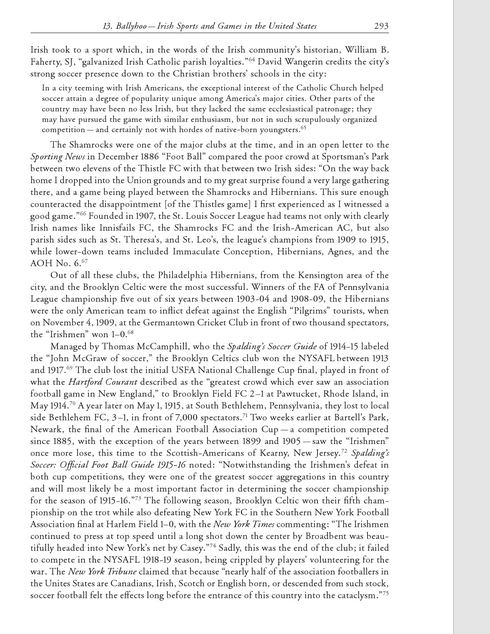
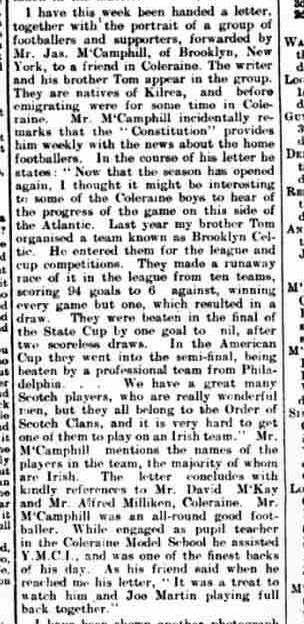
Thomas born (about) 1870, emigrated 1892.
James born 1 January 1872, son of Eneas (Enneas) McCamfil, Eliza O’Neal (O’Neill), emigrated 1895.
Both living with Margaret O’Neill in Kings, New York, on the 1900 Census.
Northern Constitution 7 October 1911.
(so possible Celtic link, in that maybe influenced by Belfast or Glasgow Celtic for the Celtic names for the names)
